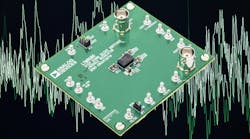Ultra-Low-Noise, Ultra-High-PSRR Regulator Module Powers Noise-Sensitive Apps
Check out our APEC 2023 digital magazine for more show coverage.
The Overview
Analog Devices Inc. (ADI) debuted its LTM8080, a super-low-noise, dual-output dc-dc μModule regulator that operates from inputs up to 40 V. The LTM8080’s front end is a high-efficiency synchronous step-down regulator followed by two separate low-noise, low-dropout (LDO) regulators.
Who Needs It & Why?
The LTM8080 is specifically designed to power digital loads that are susceptible to switching-regulator noise, such as high-speed data converters, RF transmitters, FPGA I/O and clock, op amps, transceivers, and medical scanners.
Under the Hood
One of the ways that ADI suppresses the LTM8080’s switching noise is by integrating an EMI barrier wall or shield within its packaging. The result is exceptionally low noise values of <1 µVRMS (10 Hz to 100 kHz), 2-nV/√Hz (10 kH) spot noise, and 80-dB power-supply rejection ratio (PSRR) at 100 kHz. Compared to discrete solutions without an EMI shield, ADI claims the LTM8080 reduces output ripple voltage by up to 70% for a simplified and quiet design.
The LTM8080 regulator’s integrated Silent Switcher architecture minimizes electromagnetic-interference (EMI) emissions and enables the device to pass CISPR 22 Class B and CISPR 25 Class 5 without an input filter. The adjustable switching frequency (200 kHz to 2 MHz) and selectable operation modes minimize the risk of frequency interference for very-low-noise instrumentation and high-speed/high-precision signal-chain applications.
Other features of the LTM8080 include a dual 500-mA or single 1-A output current and output voltages from 0 to 8 V. It offers a voltage tracking function to minimize power loss and a 100-μA SET pin current with ±1% initial accuracy. The device also can be used in parallel for lower noise and higher current.
The LTM8080 comes in a 9- × 6.25- × 3.32-mm BGA and starts at $12.83 each in quantities of 1,000.
Check out our APEC 2023 digital magazine for more show coverage.

